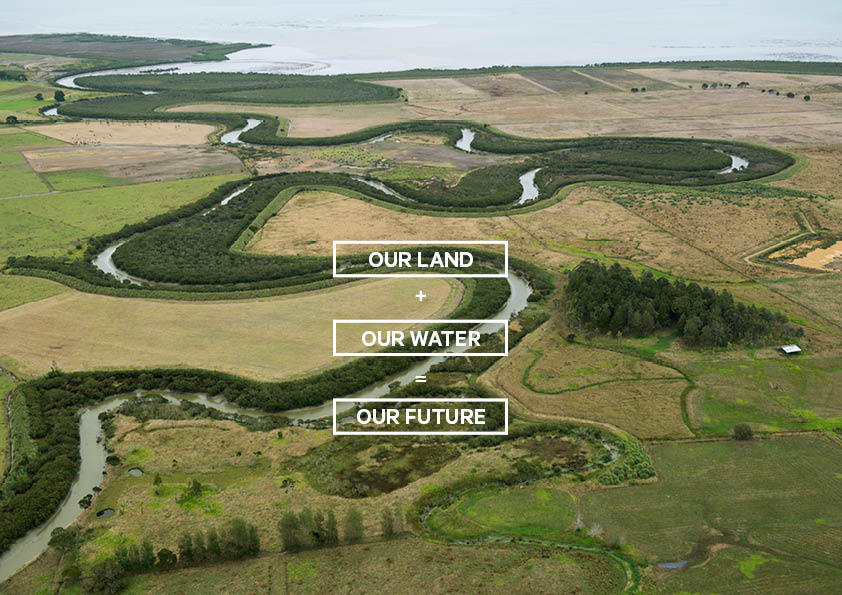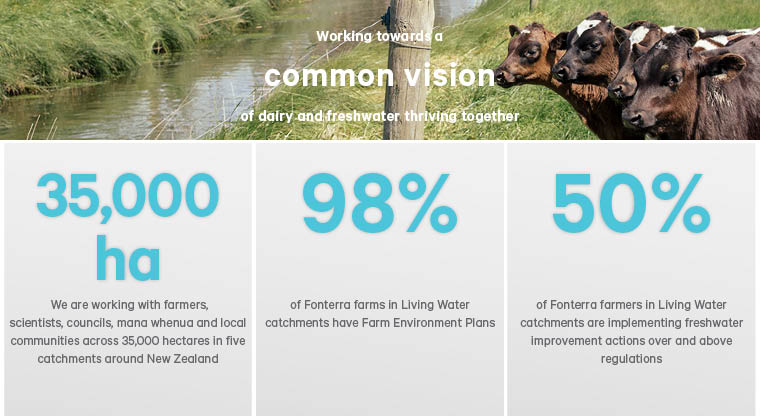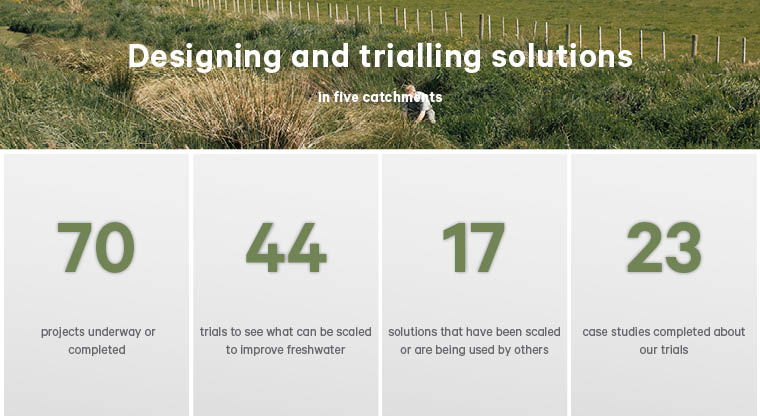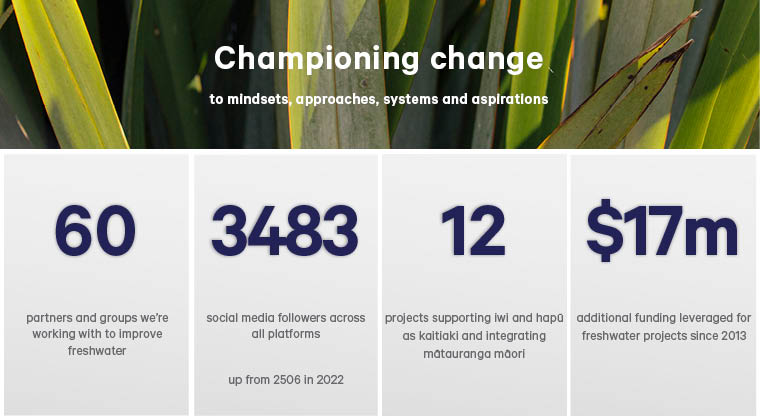
DOC and Fonterra, steering the future of freshwater
Living Water, the ten-year partnership between the Department of Conservation and Fonterra recently celebrated its tenth and final year of working together to enable farming and freshwater to thrive side-by-side / Te puāwai ngātahi a te mahi pāmu me te wai māori.
To celebrate we put together this video highlighting our achievements over ten years across five catchments.
10-year celebration video
WORKING TOWARDS A COMMON VISION OF DAIRY AND FRESHWATER THRIVING TOGETHER
Living Water encourages farmers in our catchments to work alongside Department of Conservation Rangers and Fonterra Sustainable Dairy Advisors to trial or implement practical solutions to improve freshwater.
Together we’ve accelerated on-farm change, but we know improving freshwater requires more than just on-farm action. To restore healthy functioning lowland ecosystems, we need to think, plan, and work together at a catchment scale.

DESIGNING AND TRIALLING SOLUTIONS IN FIVE CATCHMENTS
We have delivered 70 projects and 44 trials over the last ten years. Some completed by our own DOC and Fonterra teams, and many in partnership with farmers, mana whenua, local communities, scientists and with other farming and environmental organisations.
Head over to the tools and solutions page to see them all.
The projects range in scale from on-farm to catchment scale, we’ve also looked at how social initiatives like the theory of change can bring key groups together to improve freshwater.
On farm, we have successfully trialled small-scale interventions like sediment traps, bioreactors and two-stage channels. These in-stream interventions can be written into Farm Environment Plans (FEPs) to ensure on-farm tools work alongside larger catchment-scale interventions.
Catchment scale approaches need to ensure the right tools are being used in the right place, for the right reasons. The complexities of landscapes have a huge influence on the way water travels above and below land. Natural variability in landscape settings (underlying soil, geology, hydrology) can have more influence on water quality outcomes than land use alone. Landscape information is not always readily available to landowners and managers so we worked with LandscapeDNA to make data more accessible via online dashboards. This data can be integrated into FEPs as well as inform wider catchment plans like where to place constructed wetlands, detention bunds or where bigger action should be investigated like retiring land from farming. Living Water has used this data to inform the placement of interventions like peak run-off control structures, a large-scale wetland and an off-line sediment trap in the Waituna catchment.
If land is retired from farming for restoration, there needs to be a transition plan and on-going management. In the Pūkorokoro-Miranda catchment, we trialled a process called Incubate to set up a community trust with stakeholders that have different backgrounds and aspirations to manage restoration goals for 19.6ha of retired farmland adjacent to a significant area of shorebird habitat (purchased by DOC in 2018). Thanks to the Incubate project, a restoration plan and a five-year implementation strategy for the reserve are underway. Excitingly, due to being plan-ready, the reserve is now part of The Nature Conservancy’s Blue Carbon Project.

CHAMPIONING CHANGE TO MINDSETS, APPROACHES, SYSTEMS AND ASPIRATIONS
Over ten years we’ve developed 60 partnerships at place and nationally. By partnering we are making it easier for farmers, iwi and communities to accelerate freshwater improvement.
In the Ararira-LII we completed a Catchment Management Plan and Implementation Guide for the Ararira/LII drainage district. The project was co-designed by a diverse Project Team, involving representatives from Fonterra, Department of Conservation, Selwyn District Council, Environment Canterbury, Te Taumutu Rūnanga, and the LII Drainage Committee and supported by consultants Aqualinc, EOS Ecology, Learning for Sustainability, and Cawthron Institute. This catchment re-design provides a new management approach for the lowland water network that meets biodiversity outcomes, restores mahinga kai, improves water quality whilst continuing to provide land drainage. The Selwyn District Council is using the approach for catchment planning of its other land drainage districts. We are now estimating the total cost (and benefits) of catchment-scale restoration to see if it’s possible to cost lowland waterway redesign and management for the whole of New Zealand. We need to reimagine our productive landscapes for a resilient future to respond to an ever-changing climate. By prioritising nature in our productive landscapes now we will be in a better place in another ten years.
The Living Water partnership itself, along with the wider partnerships we have been involved in, have taught us it’s as much about people as it is about the environment. For example, we were a driver in the formation of the Whakamana Te Waituna Trust, set up in 2018 to oversee an integrated work programme for the internationally significant Waituna Lagoon, a RAMSAR wetland site. The Trust is a partnership between Te Rūnanga o Awarua/Te Rūnanga o Ngāi Tahu; Department of Conservation; Environment Southland; Southland District Council; and Fonterra and like many multi-agency partnerships has faced relational challenges between agencies and within the catchment community. Despite the difficulties, the partnership has led to new conversations, partnerships, and collaborations. This changed how different people with different interests can work together towards a common goal. It means they now understand each other better and appreciate both what they have in common and what makes them unique.
By working together, the programme is also creating an environment where ideas can mix, everyone can learn together, and decisions are made together. We need to put people at the heart of problem solving, with social scientists and change experts being a vital part of designing new approaches to freshwater management.
Download Living Water’s full 2023 progress report here.
After ten years, the Living Water team extends a massive nga mihi thank you to everyone who joined us on this journey, worked with us, shared their knowledge and supported this unique partnership.
